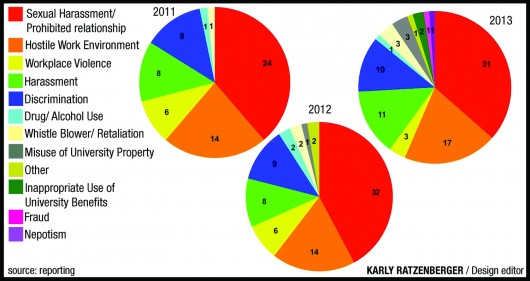Of 141 harassment and discrimination reports filed with Ohio State from 2011-13, roughly 62 percent involved a sexual harassment complaint. But that might not represent the extent of the instances, as one local lawyer said he’s sure there are more cases that went unreported.
In 2013, there were 52 reports of alleged workplace harassment and discrimination filed with OSU Office of Human Resources, according to university data.
The yearly number of reports, as compared to previous years, has increased: there were 47 reports in 2012 and 42 reports in 2011. This data represents complaints filed by any of OSU’s 43,630 employees and is not representative of Wexner Medical Center employees, as the Medical Center conducts its own harassment investigations.
Reports were investigated and determined to have either been a false allegation, to have determined inappropriate behavior occurred, to have sufficient evidence to indicate a violation of university policy, sufficient evidence to indicate that no university policy violation had occurred or insufficient evidence to indicate a violation of university policy. Of the 141 reports filed over 2011-13, 78 were found to have insufficient evidence, making up 55.3 percent of outcomes.
While the year-to-year number of reports fluctuated, sexual harassment was consistently the most common complaint reported.
OSU’s Office of Human Resources policy defines sexual harassment as “unwelcome sexual advances, requests for sexual favors and other physical or verbal conduct of a sexual nature” when it meets certain criteria.
University spokesman Gary Lewis said the university is dedicated to investigating discrimination and harassment reports.
“The Ohio State University is committed to conducting complete and thorough investigations after receiving complaints which involve any type of harassment. This commitment is both a moral imperative consistent with an intellectual community that celebrates individual differences and diversity, as well as a matter of law,” Lewis said in an email.
Sharon Cason-Adams, lead litigator at Columbus-based Adams, Liming & Hockenberry LLC, said reports found to have sufficient evidence might have the legal standing to go to court, but individuals do not have to go through the university. They could instead file a charge with the Ohio Civil Rights Commission, the U.S. Equal Employment Opportunity Commission or some other organizations.
The EEOC does not track specific university workplace discrimination, but it does keep records of workplace discrimination by state. In fiscal year 2013, the EEOC received 3,071 discrimination reports from Ohio. Of those, 815 — or 26.5 percent — were sexual discrimination reports, said Joseph Olivares, Washington, D.C.-based EEOC public affairs specialist.
Frederick Gittes of the Columbus-based Gittes Law Group said because the university’s data only represents cases reported to human resources, it is unlikely that those numbers represent the extent of harassment cases. Gittes said it is more likely that employees circumvented the university, going straight to a third-party organizations.
“I am sure there are at least some instances of discrimination reported outside the university,” Gittes said. “(The numbers) probably don’t reflect the full number of people who reported discrimination.”
Even if all of the reports — both those made inside and outside of the university — were accounted for, the number of reports would likely still not represent the extent of discrimination or harassment at OSU because many cases go unreported, Gittes said.
“Many employees are afraid to report discrimination for fear of retaliation,” he said, adding that sexual harassment cases are chief among “underreported” cases.
Harassment cases that do make it to court might be difficult to win, as the plaintiff has to persuade coworkers to testify and show that the alleged harassment was an “intentional act.”
“It’s an uphill battle for every plaintiff in this situation,” Cason-Adams said, adding that the burden of proof is on the plaintiff.



